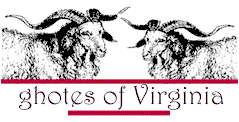 |
Index of Names for "tithable" Records
|
Click on an initial to go directly to the surnames that begin with that letter:
A B C D E F G H I J K L M N O P Q R S T U V W Y
In seventeenth- and eighteenth-century Virginia, the term “tithable” referred to a person who paid (or for whom someone else paid) one of the taxes imposed by the General Assembly for the support of civil government in the colony. In colonial Virginia, a poll tax or capitation tax was assessed on free white males, African American slaves, and Native American servants (both male and female), all age sixteen or older. Owners and masters paid the taxes levied on their slaves and servants. Few tithable lists are extant.
Tithable lists do not enumerate anyone under the age of sixteen or any
adult white woman (unless she was the head of household). Laws published in
Hening’s Statutes at Large may assist the researcher in understanding
who was considered tithable and how tithable lists were taken. In an attempt to
stop fraud concerning the “yearly importation of people into the collonie,” an
act was passed in the House of Burgesses in 1649 requiring that all male
servants imported into Virginia (“of what age soever”) be placed on the tithable
lists. Natives of the colony and those imported free who were under the age of sixteen
were exempt. (William W. Hening, ed. The Statutes at Large: Being a
Collection of All the Laws of Virginia, from the First Session of the
Legislature, in the Year 1619…[1809–1823], 1:361–362.)
Legislative History
In March 1657–8, an act passed in the House of Burgesses declared that
all African Americans and Indians (both male and female) over sixteen years of
age were to be placed on the tithable lists. Between the first and last of
June, masters were required to return a list of all tithables to the clerk of
the county court to be recorded (Hening, 1:454– 455.)
In an attempt to stop fraud among sheriffs bringing in tithable lists, the House of Burgesses passed an act in March 1660 requiring that each county be divided into four precincts. A commissioner was appointed in each precinct. The constable alerted the county’s inhabitants to bring tithable lists to their commissioner by 10 June (Hening, 2:19.) According to an act passed in the House of Burgesses on 14 March 1661–2, the commissioners, who were appointed by the court, were to post a notice on the door of the church notifying the public when the tithables would be received before the June deadline. At August court, the commissioners delivered an account of the tithables to the county court clerk, who then returned a list to the clerk of the House of Burgesses (Hening, 2:83–84.)
By an act passed in December 1662, all female servants who worked a crop
were to be considered tithable and levies were paid for them (Hening, 2:170.)
An act to discover concealed tithables was passed in the House of
Burgesses session of September 1663. Every year, masters were to give an exact
account of tithables (with names) by 10 June to the magistrate appointed to
receive the list. Masters concealing tithables forfeited a servant to the
informer. If the concealed person was a freeman or a servant with less than a
year to serve, one thousand pounds of tobacco was forfeited for each person
concealed. Women servants were exempted from this act (Hening, 2:187.)
In its continuing efforts to discover concealed tithables, the colonial government passed an act in October 1670 requiring tithable lists to be made public. At the court held after the June deadline, justices delivered the tithables to the county clerk, who made a copy and put it on the courthouse door where it remained all day. This procedure allowed persons living near those who were concealing tithes to discover and report the fraud.
Penalties for fraud were the same as those passed in the act of 1663
(Hening, 2:280.)
In the House of Burgesses session of September 1672, an act was passed
“concerning tythables borne in the country.” Those persons appointed by the
court to take tithables were also charged with taking an account of all negro,
mulatto, and Indian children. The masters or owners of these children attested
to their age. This act also required the masters or owners of African American
children and slaves born in Virginia to register their births within twelve
months in the parish register. Those who failed to register children paid a
levy on them that year and every year until the child was registered. All African
American women born in Virginia were accounted tithable at age sixteen (Hening,
2:296.)
An act for “assertaining the time when Negro Children shall be tythable” was passed in the House of Burgesses session of June 1680. This act required that all negro children imported within three months of the act were to be brought into court and their ages adjudged by the justices and recorded. Negro children were not considered tithable until twelve years of age. Christian servants imported into Virginia were not tithable until age fourteen (Hening, 2:479–480.) In the House of Burgesses session of November 1682, an act declared that all Indian women were tithable and charged with the same taxes as African American women brought into Virginia (Hening, 2:497.)
 >>> Advertise Here <<<
>>> Advertise Here <<<